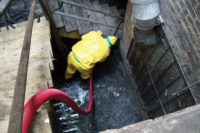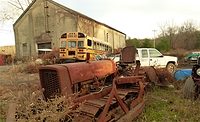Just blocks away from City Hall in downtown Philadelphia is a high-end condominium complex. It’s an old building, having been built in 1872, and one of its features is a cavernous brick basement. While this basement area is currently unoccupied, it does rest near residential living quarters. With that being said, residents were in for an unpleasant surprise recently when strong smells of sewage entered their condo units, having migrated up from the basement area.
Upon investigating, an 8-inch soil line was found to have been leaking into the area, contaminating an area of about 150 x 25 feet, in addition to three railroad car-like rooms, which measured 150 x 12 feet. It’s believed that the soil line was leaking sewage into the basement for many months before being detected, the problem so intense that plumbers refused to enter the area to repair the line until the bulk of the raw sewage was removed. And for good reason, as sewage, or black water, is grossly contaminated water that often includes pathogenic organisms consisting of viruses, bacteria and helminths.
That’s where Harry Allcroft Jr., Owner, PuroClean of Delran, and his team entered the picture, as they were called to clear out the sewage, so that plumbers could enter and solve the issue, and then clean and sanitize the basement area.
“Our first step was to bring in a ‘honey wagon’ to pump out the raw sewage and rinse all the debris off with clean water,” Allcroft says.
After pumping out the sewage and disposing of numerous dead rats that were also discovered in the area, the plumbers were able to enter and clear the clog in the pipe. Allcroft says that they had to rooter through 28 feet of pipe until the clog was cleared.
“Once the source was repaired, then we began the process of debris removal,” Allcroft explains. “There was no easy way to do this. We formed three teams. Team one bagged the contaminated debris, team two moved the debris from the affected area about 100 yards to the stairs, team three hand-carried the debris up the stairs and out to the dumpster. We would change jobs periodically to give guys a break from the hard jobs.”
When it was all said and done, some 3,000 gallons of raw sewage and 15 tons of contaminated debris was removed from the site within a three-day period. Allcroft says that only 28% of his crew lasted beyond the first day of the project, both due to the physical demands of the removal and gross conditions.
After removal came sanitization. All of the affected areas were pressure-washed with a sanitizing solution, using cold water to avoid steaming up the sewage and making it go airborne. After the first round of sanitizing was complete, drying equipment was brought in to thoroughly dry the area. After this equipment was pulled, the walls and floor were hosed down with another sanitizer.
“We knew we were getting the place clean when huge roaches started to come back into the space,” Allcroft says. “No one thought about it in the beginning, but there were no bugs or rats during the course of the project until we were almost done with it. Then we began to see them. Gives you an idea how nasty this space was.
“These jobs are very physically demanding. So for us who survived dealing with the nasty, it was like we won something. At the end of the job we could walk around the affected area seeing it all beautiful, clean and nice, remembering the horror that had once been there and the pride that goes with that knowledge. It has something to do with going into a place that very few people would even go look at, much less attempt to figure out how to clean it, and get that nasty job done. On a much lesser scale, we’re like ‘second responders.’ A firefighter will run into a burning building. We won’t do that, but we will run into a building with a basement full of enough sewage to fill a backyard pool.”
In the days since, the large loss sewage job has become a point of pride for the technicians that worked it. In fact, every time Allcroft hears a tech complaining about a particular job, either he or a veteran crew member will state, “This is nothing – you should have been there when we did the Philly sewage job!”














